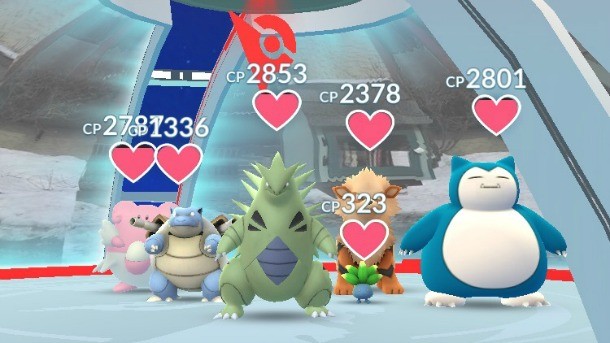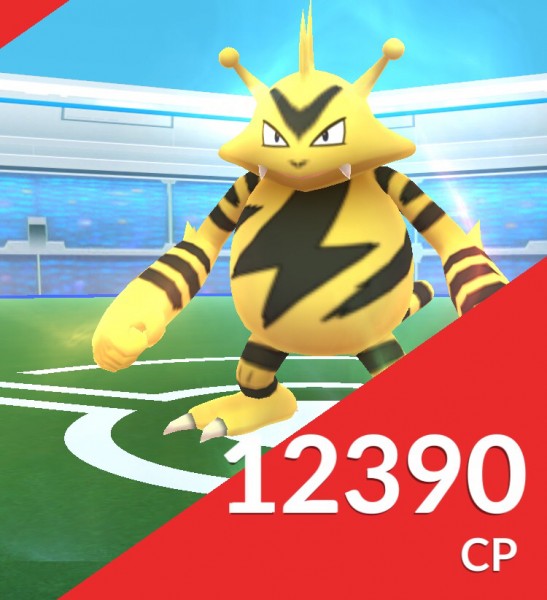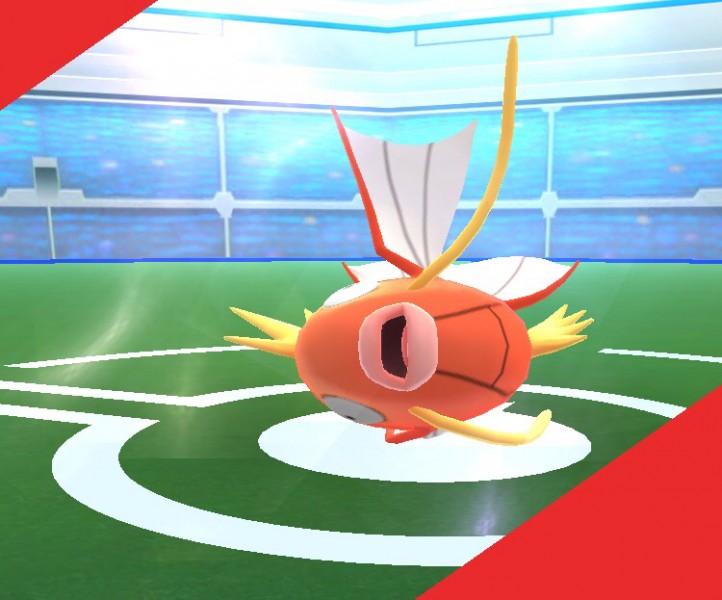Pokémon Go's New Gyms And Raids Are A Few Tweaks From Greatness

Last week, Niantic announced that its popular Pokémon Go app would receive its biggest update yet. In addition to a complete reworking of the gyms, Go would also introduce cooperative raids, which would not only give players rare items, but also the chance to capture otherwise elusive creatures. Now that the update has been live for about a week and I've had ample time to experiment with it, the additions are a net gain, but they aren't without their drawbacks.
The first part of the update features a fundamental reworking of the in-game gyms. While they remain team-based, you no longer level up a gym by training the monsters there. Instead, gyms have six permanent slots that can be filled immediately upon takeover (save for an annoying "gym is under attack" bug that pops up when a gym is first conquered).
Once in a gym, each monster gets a motivation meter, which depletes steadily over time, or in chunks as they lose battles from opposing teams. Players on the same team can refill these meters by visiting the gym and feeding berries in exchange for stardust. In addition, rather than daily bonuses, players don't receive the coins their Pokémon collects until the monster is knocked out of the gym and returns to them.
Before, it was rare that I would find a gym to throw my Pokémon into without training, meaning that unless I wanted to take time to battle through tedious training sessions, or take down an opposing gym on my own, my creatures didn't accumulate much time in gyms. With the new update forcing more turnover, the days of one team holding a gym for months at a time are largely gone. There's no incentive to hold a gym for that long, meaning that the wealth gets spread around, creating a better experience for everyone. At any given time, I have three or four Pokémon in gyms - a simple fact that has reinvigorated my passion for the game.
You earn a coin for every ten minutes your Pokémon defends a gym, meaning that you can rack up coins pretty quick. This has resulted in me receiving more coins than I ever did before, making me want to play even more. Unfortunately, Niantic has put in a 50-coin daily limit. While that makes sense in theory since the developer obviously doesn't want to give away the house through the easier-to-earn coins, (plus, they want to encourage faster turnover in the gyms) the limit is implemented in a way that defeats many purposes of the other mechanics.
The biggest mechanic to suffer from this is the berry-feeding system to re-motivate your creatures. Since any monster can only earn 50 coins per stay at a gym, there's no incentive to pour berries into your monster outside of the measly 20 stardust you receive per berry (which feels like nothing after the 500 stardust you previously received each day per monster in a gym). Also, with the daily limit not considering that multiple Pokémon can be knocked out of a gym in the same day, it could spell that a Pokémon that has gone on a massive monthlong run at a gym could return with zero coins if a Pokémon that defended its gym for two days was knocked out that morning. The speed at which the coins accumulate is generous, and I understand the need for a cap, but I can't help but wish there was a bonus amount for each day your monster was in the gym that doesn't count toward the 50-coin daily cap.
The update also converted several Pokéstops into gyms, making them more common for both urban and rural players. To alleviate concerns that players would get fewer items thanks to fewer Pokéstops, Niantic also embedded a Pokéstop in every gym. I like that in addition to more Stops, these gym Pokéstops also grant you bonuses if it's your team in control of the gym at the time of your visit. Finally, the first gym Pokéstop you visit each day grants you a free raid pass, which you can use to participate in the new cooperative boss battles.

The majority of raids are semi-rare creatures like Electabuzz and Magmar, but you'll occasionally spot an ultra-rare four-star boss.
I really dislike how you can only hold one at a time since many players can't play extensively until the weekend, but thankfully if you use a raid pass even after visiting a gym Pokéstop, you get one on your next visit. If you want to participate in more raids than the free passes allow, you need to spend real money on a premium raid pass. I wouldn't mind this monetization scheme if Pokémon Go just allowed you to hold multiple raid passes if you are unable to use the one in your possession; I wish the game would let me hoard a small number of passes for if I can't play until the weekend.
While the gym overhaul is a big change, the addition of daily raids is huge. They work by having a giant egg with a timer pop up on top of gyms (seemingly at random). When the timer reaches zero, the egg hatches to reveal a raid boss that "takes over" the gym. Players trade in a raid pass to battle the powerful boss creature. The raids allow for groups of up to 20 in a single battle, with multiple groups able to take on the boss in separate instances.
The raid bosses are massive versions of rare monsters found in the game. Venusaurs typically max out their power between 2,000 and 2,500 CP, but the raid boss Venusaur we took on was nearly 30,000 CP. Raids are rated based on difficulty. One-star and two-star raids feature Pokémon like Electabuzz, Exeggutor, Magmar, and even Magikarp, and are easily beaten by small groups of players. Encounter a four-star creature like Tyranitar in a raid, and you had better bring as many friends and strangers as you can round up.
Despite these creatures being the most powerful ever encountered in Pokémon Go, a big group can take down a mid-tier boss with astounding ease. In less than 30 seconds, my group of 20 players annihilated a 14,000 CP Magmar. After it was done, one of the strangers in my group looked up to me and said, "That's it?" It does feel anticlimactic when battles like that occur, particularly since you only get one per day unless you pay money.
At the end of a successful raid, you're graded on your performance and given premier balls, which can be used to try and capture a deflated version of the raid boss. While the CP dwindles to middling levels following the battle, the opportunity for players to capture otherwise ultra-rare Pokémon is a massive bonus for those who would probably never have the chance to do so otherwise. To top it off, if you do catch the raid boss, you get 10 candies instead of the standard 3.

Even though raids can host up to 20 players, you can take down this beast by yourself
You're also rewarded with items when you complete a raid. While revives are common, the real loot you look for are raid-exclusive items like rare candies, golden raspberries, and two kinds of technical machines. Rare candies are my personal favorite since you can trade them in for any specific Pokémon's candy you choose. Chanseys and Larvitars are extremely rare around me, but I want to power up Blissey and Tyranitar, so these are the most valuable to me. Golden raspberries give you an even greater chance of catching the Pokémon than regular raspberries do, while technical machines let you re-roll one of your Pokémon's moves depending on which kind of TM you get (fast or charged). If you're like me, these items are the real reason to take part in raids.
Since raid bosses "take over" gyms, the gym essentially shuts down during that hour. You can't interact with the gym - even after you take on the boss - until the timer reaches zero. That means that if you're in the middle of taking down an opposing gym, or you were on the way to throw your Pokémon into your team's gym with an open slot when the egg hatches, you need to wait an hour before you can complete your task. Each of those scenarios happened to me during my first week of play, and it resulted in me completing the raid and just moving on without interacting with the gym.
While this newest update certainly has its downsides and share of improvements it needs to make before Pokémon Go is the game all dedicated players know it can be, Niantic has succeeded at making it social again. During the first weekend of raids, I regularly saw large groups of players walking around together taking gyms and battling raids; a sight I haven't seen since last summer shortly after the game launched. If Niantic can continue improving the rough edges of these features while adding new mechanics and incentives to get players returning on a regular basis, Pokémon Go could reach its full potential.

Get the Game Informer Print Edition!
Explore your favorite games in premium print format, delivered to your door.
- 10 issues per year
- Only $4.80 per issue
- Full digital magazine archive access
- Since 1991









